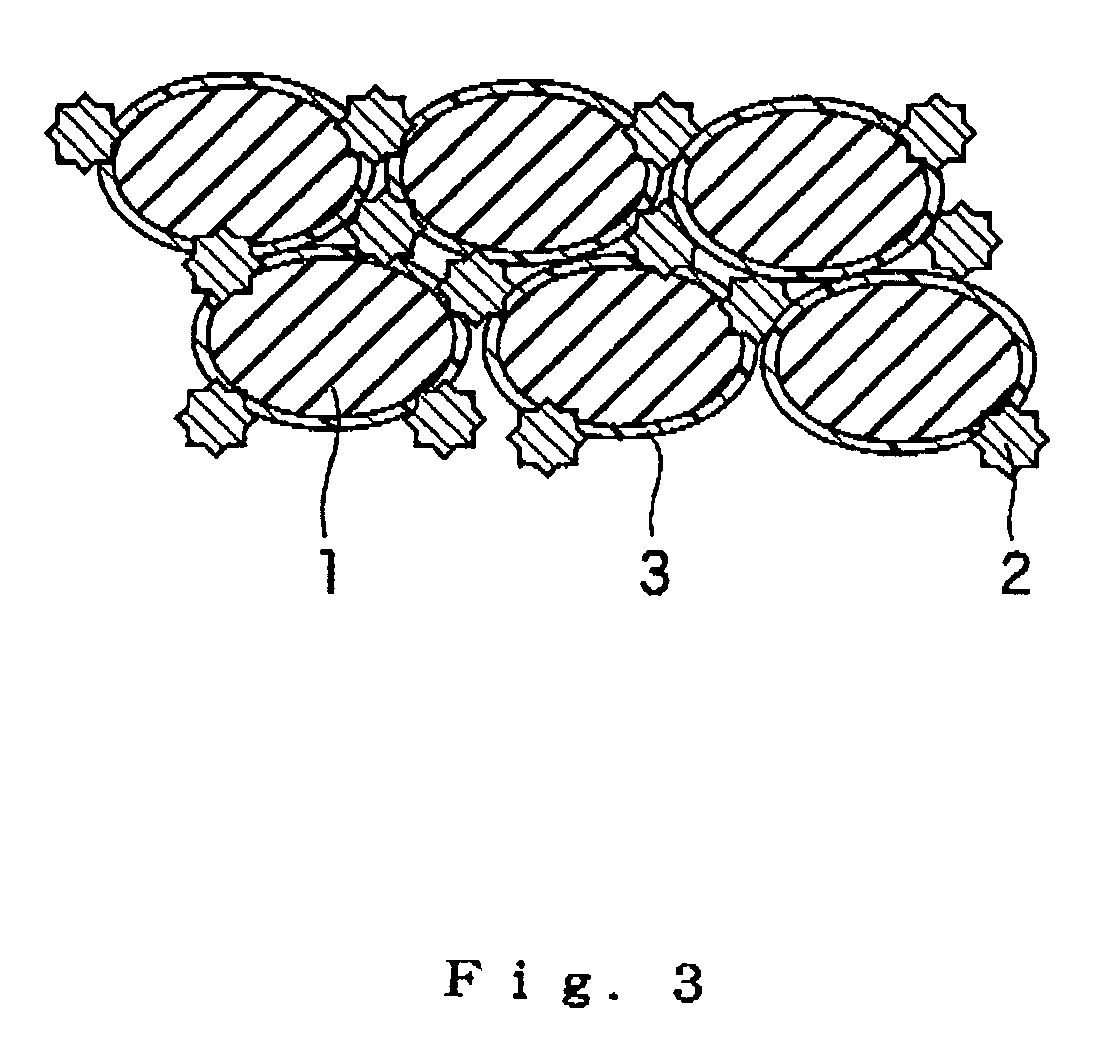Porous elastic pavement material
a technology of porous elastic and pavement, applied in the direction of climate sustainability, building components, solid waste management, etc., can solve the problems of failure to cut water films, and achieve the effect of improving wet state slip resistance, reducing noise, and reducing nois
- Summary
- Abstract
- Description
- Claims
- Application Information
AI Technical Summary
Benefits of technology
Problems solved by technology
Method used
Image
Examples
example 1
[0045]First, 45 vol % of hard aggregates (CERASAND B available from Bishu Kosan Co., Ltd.) having an average particle diameter of 0.7 mm were blended with elongated fiber-like rubber chips (FIBER RUBBER 612 available from Misawa Toyo Co., Ltd) having an average length of 6 mm and an average maximum diameter of 1.0 mm, and 20 vol % of a single-liquid moisture-curable urethane binder (TAKENATE F181P available from Mitsui Takeda Chemical Inc.) was blended with a total of 100 vol % of the elongated fiber-like rubber chips and the hard aggregates with stirring. The resulting mixture was weighed so as to provide a post-molding void content of 40%, and charged in a mold. Then, the mixture was heat-compressed at 150° C. for 30 minutes. Thus, a planar porous elastic pavement material (400 mm×400 mm) having a thickness of 30 mm was produced.
examples 9 and 10
[0048]Two types of porous elastic pavement materials were produced in substantially the same manner as in Example 1, except that longer elongated fiber-like rubber chips (FIBER RUBBER 306 available from Misawa Toyo Co., Ltd.) having an average length of 15 mm and an average maximum diameter of 1.8 mm were used in Example 9 and further longer elongated fiber-like rubber chips sieved out of the aforesaid elongated fiber-like rubber chips as having an average length of 25 mm and an average maximum diameter of 2.0 mm were used in Example 10 as shown in Table 4.
examples 11 and 12
[0049]As shown in Table 5, smaller granular rubber chips (available from Muraoka Rubber Reclaiming Co., Ltd.) having an average particle diameter of 2.5 mm and larger granular rubber chips sieved out of the Muraoka Rubber's granular rubber chips as having an average particle diameter of 4.5 mm were prepared instead of the elongated fiber-like rubber chips. Then, 40 vol % of hard aggregates (SILICA SAND No. 4 available from Okumura Ceram Co., Ltd.) having an average particle diameter of 0.7 mm were blended with each type of the granular rubber chips, and 15 vol % of a single-liquid moisture-curable urethane binder (TAKENATE F181P available from Mitsui Takeda Chemical Inc.) was blended to a total of 100 vol % of the granular rubber chips and the hard aggregates with stirring. The resulting mixture was weighed so as to provide a post-molding void content of 37%, and charged in a mold. Then, the mixture was heat-compressed at 150° C. for 30 minutes. Thus, two types of planar porous elas...
PUM
| Property | Measurement | Unit |
|---|---|---|
| particle diameter | aaaaa | aaaaa |
| particle diameter | aaaaa | aaaaa |
| particle diameter | aaaaa | aaaaa |
Abstract
Description
Claims
Application Information
 Login to View More
Login to View More - R&D
- Intellectual Property
- Life Sciences
- Materials
- Tech Scout
- Unparalleled Data Quality
- Higher Quality Content
- 60% Fewer Hallucinations
Browse by: Latest US Patents, China's latest patents, Technical Efficacy Thesaurus, Application Domain, Technology Topic, Popular Technical Reports.
© 2025 PatSnap. All rights reserved.Legal|Privacy policy|Modern Slavery Act Transparency Statement|Sitemap|About US| Contact US: help@patsnap.com



